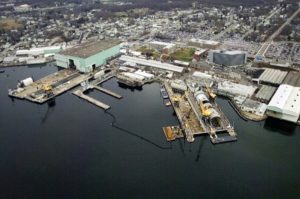The head of U.S. Indo-Pacific Command last week said the AUKUS Australia nuclear submarine effort is not expected to be a fast effort and shaving even two years off would be a “herculean” task.
During a Senate Armed Services Committee hearing on March 10, Sen. Richard Blumenbthal (D-Conn.) asked if there was any opportunity to accelerate the Australian-U.K.-U.S. AUKUS nuclear-powered attack submarine program. The partnership is currently undergoing an initial 18-month exploratory review to inform the Australian government on how it will pursue the new capability.
“I think we’ll have to see the results of this review, I guess what I would say is this really won’t happen quickly. If we can get from 10 years to eight years, boy that’d be herculean,” Adm. John Aquilino, commander of U.S. Indo-Pacific Command, said.
Last September, Chief of Naval Operations Adm. Mike Gilday said the effort to properly design, build, support and oversee a new nuclear submarine fleet may take decades before the first boat is launched (Defense Daily, Sept. 23, 2021).
Blumenthal also asked where he thinks the Australian submarines will be built. He represents one of the two key states that build the current Virginia-class nuclear-powered attack submarines for the U.S. Navy at General Dynamics’ Electric Boat [GD] in Groton, Conn.

“I know the Australians certainly would like to have that industrial capacity. I think having an additional industrial base in another place for us is possible, but as you know, all of the United States submarines are built in Connecticut,” Aquilino said.
GD Electric Boat and Huntington Ingalls Industries’ Newport News Shipbuilding jointly build the Virginia-class submarines, with each company building certain parts of each boat, taking turns building the reactors and performing final assembly for each vessel.
Aquilino also said beyond helping Australia buy and build new submarines the Defense Department is looking at cooperative posture options beyond just submarines and naval bases. He confirmed that “right now we’re completely interoperable with the Australians.”
“On the submarine side, I think that Australians need to see the result of this initial review, they will have some decisions and choices to make and then I think there’s ways to bridge to that development when, as they work to get to the infrastructure and then we review the additional basing options…we would love to go as fast as possible, we certainly have to be mindful of the nuclear reactors and the safety of those things as we work this forward,” he continued.
Blumenthal acknowledged progress as the Australian government last week announced plans to build a new submarine base to support the new AUKUS nuclear-powered submarines on the country’s East Coast (Defense Daily, March 8).
Sen. Tammy Duckworth (D-Ill.) also asked how Congress can help support AUKUS with planning in the region.
Aquilino underscored the importance of letting the 18-month period run its course first.
“I think step one is to let this report run out. So they have some decisions to make which are significant decisions as we work through the submarine portion. Once they identify a couple of key ways forward, you heard the other day they decided they are going to have a base on the East Coast, I think now we can kind of step in, partner with them and work toward some of these posture initiatives.”
Aquilino said the Defense Department will help Australia in numerous ways, like working towards developing a nuclear power school and partnering with them for riders on submarines.
“There’s a bunch of things we can do but they really have to make some choices first and I’m confident they’re looking to go as fast as possible as well.”